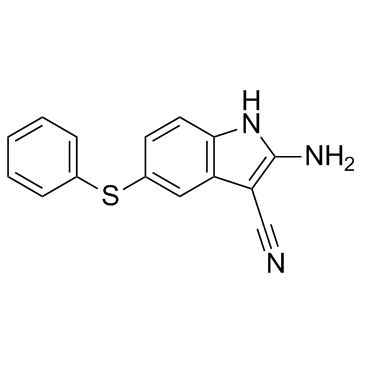Amphethinile (Amphetinile) (Synonyms: Amphetinile; CRC 82-07) |
| Catalog No.GC33370 |
Amphethinile (Amphetinile) is an anti-tubulin agent. The affinity constant for the association (Ka) of Amphethinile (Amphetinile) with tubulin is 1.3 μM.
Products are for research use only. Not for human use. We do not sell to patients.

Cas No.: 91531-98-5
Sample solution is provided at 25 µL, 10mM.
Amphethinile is an anti-tubulin agent. The affinity constant for the association (Ka) of Amphethinile with tubulin is 1.3 μM.
Amphethinile shows a remarkable similarity to colchicine in terms of its binding to tubulin and inhibition of microtubular assembly. Amphethinile binds strongly to microtubule protein (Ka=1.3 μM). This interaction has been shown to be capable of inhibiting tubulin assembly, but shows no rapid stimulation of disassembly when added to assembled tubulin. The concentration of amphethinile required to inhibit assembly by 50% (12 μM) is very similar to that for colchicine (11 μM). Amphethinile has been shown to be capable of competing for colchicine binding sites but not for those of the vinca alkaloids. Amphethinile can also be shown to stimulate the GTPase activity of tubulin in a manner similar to that observed for combretastatin A4 and 2-methoxy-5-(2',3',4'-trimethoxyphenyl) tropolone (MTPT)[1]. Amphethinile has been shown to cause a G2/M phase block in the cell cycle. In addition, this agent has been shown to be equally toxic toward parental and daunorubicin-resistant P388 cells. Whereas resistance in this cell line is associated with decreased drug accumulation in the case of daunorubicin, vincristine and vinblastine, this effect is much less pronounced for amphethinile[2].
Pharmacokinetic studies in male mice are undertaken. Area under the curve values (AUC), show that levels of 313 μg/L per hour are attained at doses equivalent to the LD10. The alpha half life is 8 min after a bolus intravenous injection. The beta half life is 100 min and relatively independent of dose level[2].
[1]. McGown AT, et al. Interaction of the novel agent amphethinile with tubulin. Br J Cancer. 1989 Jun;59(6):865-8. [2]. McGown AT, et al. Pre-clinical studies of a novel anti-mitotic agent, amphethinile. Br J Cancer. 1988 Feb;57(2):157-9.
Average Rating: 5 (Based on Reviews and 33 reference(s) in Google Scholar.)
GLPBIO products are for RESEARCH USE ONLY. Please make sure your review or question is research based.
Required fields are marked with *




















